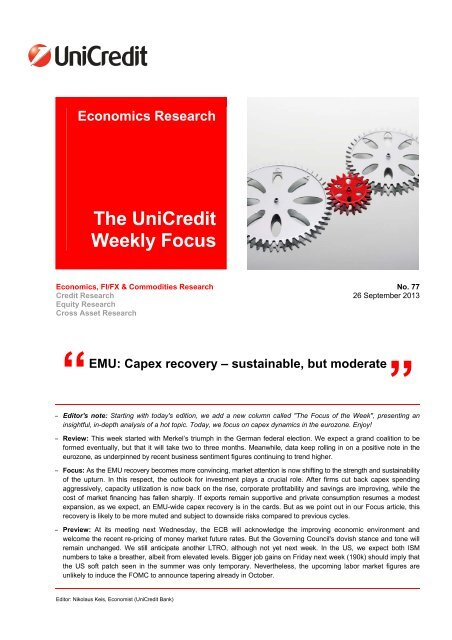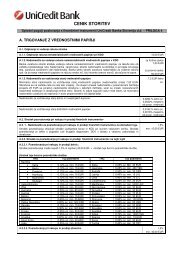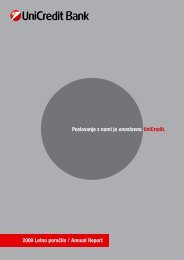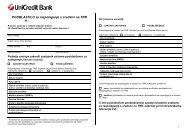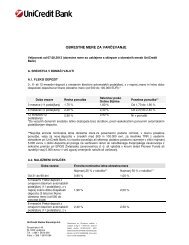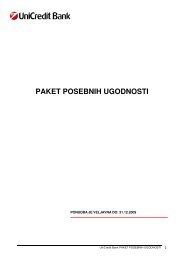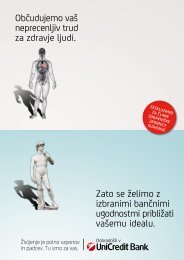Economics Research The UniCredit Weekly Focus
Economics Research The UniCredit Weekly Focus
Economics Research The UniCredit Weekly Focus
Create successful ePaper yourself
Turn your PDF publications into a flip-book with our unique Google optimized e-Paper software.
26 September 2013 <strong>Economics</strong> & FI/FX <strong>Research</strong><strong>Weekly</strong> <strong>Focus</strong>CEE: Central banks moved centre stageWith only a few but promising data releases in Central and Eastern Europe (economic andindustrial sentiment up the Czech Republic and Turkey) underpinning the catch-up process ofthe region, central bank meetings took center stage this week. In line with expectations, theNational Bank of Hungary delivered another 20bp rate cut, bringing the policy rate down to3.60% in an effort to shore up the recovery and contain the interest bill of the government.While the risk of deeper cuts to 3% has increased, we maintain our call for cuts down to3.50% by the end of the year. Having reached the zero level of the key rate already in late 2012,the focus of Czech monetary policy is on FX interventions. But the proposal to start interventionshas again failed to win a majority in the Board. Former statements of some central bankerssuggest that they have been reluctant to use such a controversial policy tool unless theyobserve an acute risk of deflation. Overall however, the CNB remained dovish, thus leavingthe door open for FX interventions further down the road.More mixed US data<strong>The</strong>re were only a few important data releases outside Europe. While Asian data were promisingon balance (Chinese Markit/HSBC PMI, Japanese SME confidence, Taiwanese export orders –all were up), US numbers were pretty mixed, hinting at a somewhat softer 3Q13 quarterfollowing an unrevised spring quarter (+2.5% qoq). This week’s business surveys (the relativelynew nationwide Markit manufacturing PMI as well as the Empire State and Philly Fed surveyswere down, as will also be the case for next week’s ISM figures (see our preview section). Butlevels are still solid-to-strong, underpinning our view that the US recovery will gain furthertraction down the road – once the debt ceiling discussion will be completed, which is currentlyweighing on sentiment and activity. <strong>The</strong> recent decline in US consumer confidence fits intothis pattern, although the level is still near the highest level since late-2007. On a positivenote, durable goods orders and shipments (especially core capital goods) as well new homesales substantially improved versus the disapprovingly strong pre-month drops.Nikolaus Keis, Economist(<strong>UniCredit</strong> Bank)+49 89 378-12560nikolaus.keis@unicredit.de<strong>UniCredit</strong> <strong>Research</strong> page 4 See last pages for disclaimer.
26 September 2013 <strong>Economics</strong> & FI/FX <strong>Research</strong><strong>Weekly</strong> <strong>Focus</strong>Capex weakness has reached an unprecedented levelIn line with the improvement of the overall economy, capex resumed expanding in 2Q13(+0.7% qoq) after six consecutive quarters of contraction. Is this a one-off improvement, ordoes it mark the beginning of a sustainable recovery trend?Chart 3 shows the evolution of eurozone capex as a share of GDP (the ratio is computed usingnominal variables). In 2Q13, this ratio held steady at an all-time low of 6.1%, which is evenbelow the levels seen in the course of 2009. <strong>The</strong> picture does not materially change when thedefinition of capex is broadened to include investment in intangibles (the black line in thechart). Note that both ratios show a structural declining trend, part of which is probably due tothe increased tendency of companies to move abroad some of their production processes.Despite this structural declining trend, the ratios do provide valuable cyclical information.Basically, they tell us that the current degree of capex weakness is unprecedented whenmeasured relative to the state of the overall economy. We suspect that this can be mostlyexplained by the big increase in systemic risk related to the escalation of the debt crisis inmid-2011, which severely restrained investment spending not only in periphery, but also incore countries. This can be seen in chart 4, which plots capex/GDP for Germany and France.In theory, a depressed level of capex/GDP signals increasing upside potential for capitalexpenditure, but per se this is not sufficient to trigger a capex rebound. A genuine revivalrequires an improvement in corporate fundamentals, which allows firms to expand capex inresponse to the impulse provided by a brightening exports outlook and renewed (albeit modest)growth in private consumption. Survey indicators and hard data published in the last fewmonths make us very confident that this impulse is indeed materializing, and is likely to besustainable. Hence, we now turn to analyzing corporate fundamentals. We then look at themain factors which could hamper a potential recovery in capital expenditure.Fundamental drivers of capex are improving<strong>The</strong> need for companies to expand their capex generally emerges when higher demand startspushing up capacity utilization rates, and firms witness an improvement in both their profitabilityand the state of health of their balance sheets. We look at these variables below, assessingrecent evolutions and prospects.Capacity utilization: Capacity utilization at euro area manufactures troughed in 2H12, but hasonly recently shown the first signs of recovery. At 78.3%, the rate remains low by historicalstandards. It is below both the average since the inception of the euro in 1999 (80.8%) andthe average between 1999 and mid-2008, i.e. before the intensification of the credit crisis andthe subsequent unprecedented drop in activity (in this case, the average rises to 82.8%).CHART 3: CAPEX/GDP IN EMU…CHART 4: … AND IN THE CORE8.508.258.007.7510.009.759.509.259.59.08.5Capex/GDP (%)Germany - LSFrance - RS6.56.07.507.257.009.008.758.508.07.55.56.758.256.50Capex/GDP, in % - LS8.006.25(Capex inc. Intangibles)/GDP, in % - RS7.756.007.501Q95 2Q97 3Q99 4Q01 1Q04 2Q06 3Q08 4Q10 1Q137.05.06.56.04.51Q 95 2Q 97 3Q 99 4Q 01 1Q 04 2Q 06 3Q 08 4Q 10 1Q 13Source: Eurostat, National Sources, Thomson Datastream, <strong>UniCredit</strong> <strong>Research</strong><strong>UniCredit</strong> <strong>Research</strong> page 6 See last pages for disclaimer.
26 September 2013 <strong>Economics</strong> & FI/FX <strong>Research</strong><strong>Weekly</strong> <strong>Focus</strong>Chart 5 shows that capacity utilization and the yoy change in capex tend to move in synch,especially since 2005: therefore, the former (which is more timely available) provides valuableinformation to track the capex cycle and spot its turning points. But a simple graphical inspectiondoes not tell the whole story. We want to dig further into the relationship between capacityutilization and capex, and as a first step we estimate the level of the utilization rate whichtriggers capex expansion plans by firms. Our regression puts this threshold at around 80%.As a second step, we investigate whether capex reacts only to the level of capacity utilization,or also to its change. Accordingly, we augment the previous model with a term which measuresthe change in capacity utilization, i.e. a momentum term. <strong>The</strong> results are interesting:in the augmented model, the momentum term is more significant than the level term, and thesignificance of the latter even slightly increases with respect to the level-only model of the firststep. This suggests that when firms plan their investment decisions, they look at both thechange and the level of capacity utilization, and assess these two variables separately. Whilethe level of capacity utilization is a rather intuitive driver of capex – firms start to invest onlywhen utilization rates climb above a certain threshold, in our model 80% – the very strongsignificance of the momentum term is less obvious. We think it may be related to the fact thatcapacity utilization is characterized by high persistency: this provides turning points in theutilization rate with an important signaling effect, which induces firms to change their capexplans in anticipation of the new trend before the critical 80% threshold is hit.<strong>The</strong> main practical implication of these findings is that the current low level of capacity utilizationis not at all inconsistent with the beginning of a capex recovery, provided that the upwardtrend in the utilization rate will not be reversed. As a matter of fact, our simple frameworkcorrectly predicted the modest improvement in capital expenditure recorded in 2Q13.Profitability: Corporate profitability is among the key determinants of capex. This can beseen from the tight correlation between the gross operating surplus – the national accountequivalent of EBITDA – and capex (see chart 6). In turn, profitability moves in tandem withlabor productivity, as shown in chart 7 next page. After the prolonged deceleration in thegrowth rate of productivity that began in the spring of 2011, the tide has now started to turn. In 1H13,labor productivity posted two consecutive qoq increases, and qualitative indications comingfrom business surveys show that the trend continued in 3Q13. For example, the rising gapbetween the output and the employment index of the Composite PMI suggests an acceleration inthe pace of improvement of productivity (see chart 8 next page).Given that a number of countries witnessed labor hoarding and a corresponding worsening ofprofitability during the downturn, it is likely that the economic recovery will remain a joblessone for some time. This appears to be a necessary development, which will allow firms tore-build profit margins and, hence, put the investment recovery on stronger foundations.CHART 5: CAPEX AND CAPACITY UTILIZATION HAND IN HANDCHART 6: PROFITABILITY IS A KEY DRIVER OF CAPEX871510158510810838179506425077-50-575-10-2-107371Capacity Utilization (%) - LS69Capex (% yoy) - RS671Q 96 4Q 98 3Q 01 2Q 04 1Q 07 4Q 09 3Q 12-15-20-25-4-6Gross Operating Surplus (% yoy) - LS-8Capex (% yoy) - RS-101Q96 4Q98 3Q01 2Q04 1Q07 4Q09 3Q12-15-20-25Source: EC, Eurostat, Thomson Datastream, <strong>UniCredit</strong> <strong>Research</strong><strong>UniCredit</strong> <strong>Research</strong> page 7 See last pages for disclaimer.
26 September 2013 <strong>Economics</strong> & FI/FX <strong>Research</strong><strong>Weekly</strong> <strong>Focus</strong>CHART 7: PROFITABILITY VS. LABOR PRODUCTIVITYCHART 8: FURTHER PRODUCTIVITY IMPROVEMENT AHEAD31038.021864216.04.00-1-220-20-1-22.00.0-3-4-5Productivity (% yoy) - LSGross Operating Surplus (% yoy) - RS-4-6-8-10-3-4-5Productivity (% yoy) - LSComposite PMIOutput-Employment - RS-2.0-4.0-6.01Q96 4Q98 3Q01 2Q04 1Q07 4Q09 3Q123Q98 2Q00 1Q02 4Q03 3Q05 2Q07 1Q09 4Q10 3Q12Source: Eurostat, Markit, Thomson Datastream, <strong>UniCredit</strong> <strong>Research</strong>External financing needs: <strong>The</strong> financing gap of non-financial corporations (NFCs) is a flowvariable which measures the difference between corporate savings and investment. Accordingly,it gauges the corporate sector’s reliance on external sources of financing. Until 2011, thefinancing gap and capex displayed a clear cyclical pattern according to which an improveddeficit position paved the way for an investment recovery, while a large deficit was reached ator close to the peak of the investment cycle (see chart 9). <strong>The</strong> rationale behind this is simple.<strong>The</strong> investment upswing usually begins when firms have sufficiently boosted profitability andinternally-generated funds, thus reducing their reliance on external financing. Over time, thestrengthening of the investment recovery progressively leads to higher borrowing needs andincreased firms’ vulnerability to shocks.In 2011, this pattern broke down, given that the investment downturn started when firms’financing gap was still roughly balanced, i.e. a rather solid position on a historical perspective.This development underscores the importance of corporate debt – a stock variable – whenassessing prospects for investment and firms’ vulnerability to shocks in the current context.As a matter of fact, if we take the financing gap position of euro area NFCs in isolation, theimplications for capex would be unmistakably bullish at this stage of the business cycle.However, the fact that corporate debt/GDP remains at around 100% and has failed to declinesince the beginning of the credit crisis (see chart 10) suggests that the real picture may beless favorable.CHART 9: FINANCING GAP VS. CAPEXCHART 10: INDEBTEDNESS OF NFCS REMAINS HIGH31021500-1-2-5-3-4-10-5-6-15-7-8-9NFCs: Financing gap (% of GVA) - LSCapex (% yoy) - RS-20-253Q99 4Q01 1Q04 2Q06 3Q08 4Q10 1Q13NFCs Debt*/GDP (%)170160150SpainFrance140Portugal Italy130Eurozone12011010090807060*loans + debt securities504Q00 2Q02 4Q03 2Q05 4Q06 2Q08 4Q09 2Q11 4Q12Source: Eurostat, Thomson Datastream, <strong>UniCredit</strong> <strong>Research</strong><strong>UniCredit</strong> <strong>Research</strong> page 8 See last pages for disclaimer.
26 September 2013 <strong>Economics</strong> & FI/FX <strong>Research</strong><strong>Weekly</strong> <strong>Focus</strong>Vulnerability factor #1: high corporate leverageTo get a better understanding of the implications of high corporate indebtedness, we look atthe experience of Japan’s corporate sector after the eruption of the financial crisis in 1990.Just to be clear: we are not suggesting that in the euro area as a whole the corporate sector isfacing problems of the same magnitude as in Japan in the aftermath of the 1990s crisis. As amatter of fact, corporate indebtedness in the euro area is currently well below the 150% peakrecorded in Japan in the mid-1990s. However, a comparison may be helpful for two reasons.First of all, there are some specific euro area countries where the corporate debt position issimilar to that of Japan in the first years of the crisis. In this regard, Portugal stands out as aproblematic country, both for the level of debt and the lack of a downward trend, while Spainconcerns us for the debt level, but not for its trend (pointing south at a decent pace). Second,the experience of Japan gives a good sense of the multi-year implications for investmentwhich can originate from a phase of corporate deleveraging after a credit-fuelled boom.Chart 11 shows that the corporate debt overhang in Japan was followed by a very long periodwhen firms turned into net savers, and significantly so. This allowed the corporate sector tostart reducing its leverage. This process has been running for fifteen years, and a stop orreversal to the net lending position of Japanese NFCs does not seem imminent. In the meantime,Japan’s “new normal” has become one where private non-residential investment as a share ofGDP has fluctuated in a narrow range, significantly below the levels prevailing before thefinancial crisis (see chart 12).Overall, some broad similarities with the Japanese experience suggest caution when assessingthe upside potential for capex in the eurozone. We suspect that the upcoming capexrecovery will be less strong and more subject to downside risks compared to pre-crisis cycles.CHART 11: JAPANESE FIRMS STILL IN SAVING MODECHART 12: JAPAN’S “NEW NORMAL” AMID DELEVERAGING10.08.06.04.02.00.0-2.0-4.0-6.0-8.0-10.0-12.0-14.0NFCs: Financing gap (% GDP) - LSNFCs: Debt/GDP (%) - RS901980 1984 1988 1992 1996 2000 2004 2008 2012160150140130120110100Private non-residential investment (% of GDP)212019181716151413121980 1984 1988 1992 1996 2000 2004 2008 2012Source: BIS, Cabinet Office, Thomson Datastream, <strong>UniCredit</strong> <strong>Research</strong>Vulnerability factor #2: tight lending standards<strong>The</strong> cost of market financing for eurozone firms has dropped considerably in the last year,thanks to the strong performance of equity and corporate bond markets after the OMTannouncement. However, only a limited number of euro area companies have benefited fromthis improvement. Given that most firms, particularly in the periphery, do not have access tomarket financing and rely chiefly on bank lending, supply-side credit constraints are anotherkey headwind to consider when assessing the strength and sustainability of a capex recovery.<strong>The</strong> main risk to evaluate is whether banks may not be ready/willing to increase loan supplywhen credit demand enters a moderate recovery phase. While this is certainly a possibility,we have reasons to believe that the recent signs of broader economic recovery will progressivelycontribute to alleviate some of these concerns.<strong>UniCredit</strong> <strong>Research</strong> page 9 See last pages for disclaimer.
26 September 2013 <strong>Economics</strong> & FI/FX <strong>Research</strong><strong>Weekly</strong> <strong>Focus</strong>This cautious optimism is due to the fact that most of the current net tightening of credit standardsis explained by factors directly influenced by economic developments – namely, banks’expectations regarding general economic activity and industry-specific outlook. Both factorscan be expected to improve in an environment of gradual economic recovery, thereby inducing amore favorable risk assessment by banks, which would in turn lead to less tight creditstandards (and potentially also an outright easing). <strong>The</strong> strong correlation between thechange in credit standards induced by economic developments and a timely gauge of economicactivity like the Composite PMI supports this assumption (see chart 13).In any case, one should not forget that it is the second derivative of credit standards – i.e. thechange in the net easing/net tightening – which matters most for sequential capex growth.Given that the pace of net tightening started to slow in 2H12 on the back of the positive OMTramifications (see chart 14), lending constraints on investment have already been slowlydiminishing for some time. We think a further, more visible improvement will materialize in thenext few quarters, possibly also helped by another long-term liquidity injection by the ECB.CHART 13: BANKS’ RISK AVERSION SET TO EASECHART 14: TIGHTENING OF CREDIT STANDARDS IS SLOWING80Factors affecting credit standards -economic and sector specific outlook (%) - LSComposite PMI - RS (inv.)3570Credit standards for loans to NFCs - net balance (%)70604060505040302010455055403020100-10600-10-204Q02 2Q04 4Q05 2Q07 4Q08 2Q10 4Q11 2Q1365-204Q02 2Q04 4Q05 2Q07 4Q08 2Q10 4Q11 2Q13Source: ECB, Markit, Thomson Datastream, <strong>UniCredit</strong> <strong>Research</strong>Having said that, we emphasize that banks’ risk aversion is not the only factor which currentlyrestrains the supply of loans: a capital shortfall also plays an important role. <strong>The</strong> upcomingECB’s asset quality review (AQR) and the subsequent stress tests will be key to improvetransparency and quantify this capital shortfall. Restoring an appropriate level of bankcapitalization will be of outmost importance to make the investment recovery fully sustainable.Assuming that the AQR and the stress tests will not be finalized before mid-2014, it will probablytake another year or so before the area-wide banking sector is fully recapitalized. If this processruns relatively smoothly with no major impact on banks’ funding costs, most of the residualsupply-side constraints to lending activity are likely to dissipate early in 2015. This will furtherreduce the core-periphery gap both in terms of loan availability and cost, in turn generating ameaningful improvement in the transmission mechanism of monetary policy.<strong>The</strong> remaining uncertainty on banks' ability to lend, and the cost of such lending, rests onbanks’ adjustment to the new regulatory environment, particularly if additional measures wereto be required (for example, capital add-ons). Visibility on this risk factor remains low.Marco Valli, Chief Eurozone Economist(<strong>UniCredit</strong> Bank Milan)+39 02 8862-8688marco.valli@unicredit.eu<strong>UniCredit</strong> <strong>Research</strong> page 10 See last pages for disclaimer.
26 September 2013 <strong>Economics</strong> & FI/FX <strong>Research</strong><strong>Weekly</strong> <strong>Focus</strong><strong>The</strong> Week Ahead<strong>The</strong> upcoming economic week will be dominated by next Wednesday's ECB meeting (reaffirmingthe bank’s prudent and dovish stance), the final round of global sentiment figures trendinghigher (but breathing in the US) as well as an US labor market improving further, but unlikelyto trigger any Fed action.ECB to remain dovishWe expect next Wednesday's ECB meeting (Thursday is a public holiday in Germany) to berather uneventful. It is extremely likely that rates will remain unchanged, and we do not foreseeany new unconventional measure at this stage. <strong>The</strong> intra-meeting period has been characterizedby two main features: a confirmation of the recent improving trend in growth indicators and adovish re-pricing of money market future rates.On the growth front, the news has been encouraging. In September, the Composite PMI rosefor the sixth consecutive month to a level consistent with 0.2-0.3% qoq GDP growth (see ourreview section). In addition, the German Ifo increased moderately further, confirming thebroad-based nature of the German recovery, while some "paybacks" in business sentiment(manufacturing PMIs, INSEE headline) are just a breather after the previous spurt. Overall,however, the encouraging data are unlikely to convince the ECB to reconsider the downsiderisks to its own GDP outlook. Accordingly, Draghi will continue to sound dovish, and the forwardguidance will be confirmed in its current version.On the interest rates front, the re-pricing in money markets has been significant. <strong>The</strong> impliedrate of the December 2014 Euribor contract has declined by 20bp since the September 5 ECBmeeting, with most of the move caused by US-specific factors, namely a lackluster non-farmpayroll figure and the Fed’s decision to keep QE3 purchases unchanged. <strong>The</strong> remaining partof the rally in short rates is mostly explained by a number of dovish statements by ECB officials,including Draghi, who have left the door wide open to further easing measures. We expectthe ECB to remain alert and “ready to act” on liquidity. On balance, the latest rhetoricstrengthens our view that the ECB will launch another LTRO in the coming months, but thetiming of the new operation has become more uncertain. A delay in the scaling back of Fedasset purchases (with the EUR appreciation remaining so far modest in trade-weighted terms)raises the probability that the ECB may decide to wait until early 2014 before acting.EMU: A WELCOME RALLY IN SHORT RATES0.750.70Euribor Dec-14 (implied rate, %)0.650.60ECB forward guidance0.550.500.450.401-Jul 13-Jul 25-Jul 6-Aug 18-Aug 30-Aug 11-Sep 23-SepSource: Bloomberg, <strong>UniCredit</strong> <strong>Research</strong><strong>UniCredit</strong> <strong>Research</strong> page 11 See last pages for disclaimer.
26 September 2013 <strong>Economics</strong> & FI/FX <strong>Research</strong><strong>Weekly</strong> <strong>Focus</strong>Global business sentiment – the trend keeps heading northWhat has already been indicated by this week's readings should be confirmed next week bythe final round of global business sentiment figures: 1. <strong>The</strong> overall trend continues to headnorth, indicating that the global economy keeps recovering – albeit at a moderate pace;2. Following the previous spurt, manufacturing (sentiment) is taking a breather (and nothingmore than a breather) in Europe and the US, while its services counterpart keeps advancingin most countries, and 3. China's manufacturing sentiment is improving again, thus helping tostop the decoupling of the overall Emerging Market figure from the Developed World numberseen over recent months.In the eurozone, the pattern seen in September flash PMI readings for the EMU, Germanyand France should not only be confirmed next week but will most likely also show up in Italy,where the September figures will be published next Tuesday. We expect the CompositePMI to advance further, solely driven by the services component (up from 48.8 to 49.5). Itsmanufacturing counterpart, however, is expected to edge down slightly (51.0 versus 51.3).This would be the first decline following five monthly increases which pushed the index abovethe important 50 threshold this summer – but will be nothing more than just a breather in anotherwise well-established upward trend as indicated by the forward-looking orders-toinventory-ratio.Within five months, the new orders subcomponent even jumped by 12.2 pointsto 53.3 (see chart next page), while the inventory sub-index declined to 46.1 – the lowest levelsince August 2010! Beyond short-term fluctuations, industrial activity should, therefore,improve further. Even with the moderate decline in September, the manufacturing PMI impliesa broad stabilization in industrial output in the current quarter after a pronounced 1.0% qoqdecline in 2Q13. This would be consistent with our forecast of a flat GDP reading for 3Q13.Outside Europe, the sentiment trend is also clearly heading north, first and foremost in the US.Sentiment among businesses across the country continues to be supported by animproving economic outlook – at home and abroad. But given the surge over recent monthscatapulting readings up to multi-year highs of 55.7 (manufacturing) and 58.6 (services) inAugust, it would be foolhardy to expect the indicators to improve each and every month. Thisis even more true at times of increasing concerns about the upcoming fiscal policy fight (debtceiling) and uncertainties about implementation of the new health care legislation, whichkicks-in on 1 October. We therefore expect both US ISM barometers to take a breather andease temporarily – with the manufacturing ISM most likely down 1.2 pts to 54.5.Business sentiment in Asia is also brightening (again). Japan took its breather already in July,when the spectacular advance of the Markit/JMMA manufacturing PMI of more than 7 ptssince the start of the year was interrupted. But the 1.6 pts decline was already matched inAugust, and the September reading (out next Monday) is expected to advance to a 2½ yearhigh at 52½. This is at least indicated by the improved Shoko Chukin small firm sentiment thatedged up in September. Its October outlook reading, if realized, would be the highest levelsince November 2006! <strong>The</strong> Tankan outlook component was promising as well, indicating thatthe recovery momentum of the Japanese economy remains intact.At the same time, there is growing evidence that the growth slowdown in industrial (and thuseconomic) activity in Emerging Asia may have run its course, at least in China. Following theshift in economic policy, the lagged effects of the credit surge seen earlier this year andimproving external demand, we expect the official NBS manufacturing PMI (to be publishednext Monday) to rise by 0.5 pts to 51.5, an improvement already signaled by this week's flashreading of its Markit/HSBC counterpart. An improving manufacturing sentiment in China(and maybe other Emerging Asian countries as well given first hints of improving externaldemand/orders) could prevent the (sentiment) divergence between Emerging Markets and theDeveloped World seen over recent months to develop further (see right chart next page).<strong>UniCredit</strong> <strong>Research</strong> page 12 See last pages for disclaimer.
26 September 2013 <strong>Economics</strong> & FI/FX <strong>Research</strong><strong>Weekly</strong> <strong>Focus</strong>ITALY: BUSINESS SENTIMENT CLEARLY TRENDING NORTHSENTIMENT IN EMERGING ASIA IS STABILIZING7065605550605550Manufacturing PMI454540353025Manufacturing PMINew orders component4035G-4 (US, EMU, UK, Japan)BRICEmerging Asia20Aug-00 Oct-02 Dec-04 Feb-07 Apr-09 Jun-11 Aug-1330Jan-08 Jan-09 Jan-10 Jan-11 Jan-12 Jan-13 Jan-14Source: BLS, Department of Labor, <strong>UniCredit</strong> <strong>Research</strong>US: Higher job gains unlikely to trigger October Fed action<strong>The</strong> lackluster August employment report was one of those factors that led the Fed to delaytapering – even if FOMC members' deeper-than-generally-appreciated concern about thedebt ceiling discussion was the tipping point. In any case, investors are eager to see whetherthe September employment report, to be released on Friday of next week, will show fasteremployment growth that brings the US economy closer to the sustainable labor marketimprovement that the Fed wants to see before starting to reduce its bond purchases. We thinkthat payroll gains accelerated further in September to 190,000 from 169,000 seen in Augustand a mere 104,000 in July. Initial jobless claims, the most timely labor market indicator, evendropped to a 7½ year-low in early September. And while issues with seasonal factors mayhave exaggerated the decline, the downward trend unequivocally signals that the pace oflayoffs has continued to improve. Hiring activity, on the other hand, remains more of aconcern. Companies might have been even more cautious due to the looming fiscal deficitbattle and the uncertainties about the details and start of Obamacare. Our forecast, whichlooks for payroll gains to return to their 1H13 monthly average, implies that the weaknessseen in the summer is a temporary breather rather than the start of a downward trend. But willit be enough to prompt the Fed to announce lower monthly asset purchases at the upcomingmeeting? We doubt it. Atlanta Fed President Lockhart, a centrist whose views tend to representthe Fed's consensus, told the Wall Street Journal that he does not think there will be anaccumulation of enough evidence to dramatically change the picture of an economy definedby "ambiguous" economic data and facing government budget showdowns in coming weeks. 2Forecasting short-term developments of the unemployment rate continues to remain more anart rather than a science. Despite modest employment gains, the jobless rate fell to 7.3% inApril, the lowest since late 2008. <strong>The</strong> decline was once again triggered by a decline in theparticipation rate, which fell in August to 63.2%, the lowest level since 1978! According to ourcalculations, the actual participation rate is 1.4pp below its "fair" value of 64.6%, i.e. the levelwarranted by demographic developments. With the participation rate at this fair level, theunemployment rate would stand at 9.3% (see right chart below). We continue to expect thatfrustrated people will eventually return to the labor force once a pick-up in hiring activityimproves overall jobs prospects. That will lift the participation rate and slow the decline in thejobless rate – or even partly reverse the latest downward moves. But this did, most likely, nothappen this September. Accordingly, we expect that the jobless rate stabilized at 7.3%.2 Two Fed Officials Stay Put on Bond Buys, Wall Street Journal, 24 September 2013.<strong>UniCredit</strong> <strong>Research</strong> page 13 See last pages for disclaimer.
26 September 2013 <strong>Economics</strong> & FI/FX <strong>Research</strong><strong>Weekly</strong> <strong>Focus</strong><strong>UniCredit</strong> FI/FX & Commodity ForecastsINTEREST RATE & YIELD FORECAST (%)end-3Q end-4Q end-1Q end-2Q2013/14 current <strong>UniCredit</strong> Forward* <strong>UniCredit</strong> Forward* <strong>UniCredit</strong> Forward* <strong>UniCredit</strong> Forward*Euro areaRefi Rate 0.50 0.50 0.50 0.50 0.50 0.50 0.50 0.50 0.503M Euribor 0.22 0.22 0.22 0.25 0.29 0.25 0.33 0.35 0.4310Y Bunds 1.81 1.90 1.82 2.00 1.96 2.20 2.03 2.40 2.10USFed Funds Target Rate 0.25 0.25 0.25 0.25 0.25 0.25 0.25 0.25 0.253M USD Libor 0.25 0.26 0.24 0.26 0.29 0.30 0.31 0.30 0.4410Y Treasuries 2.63 2.90 2.63 3.00 2.76 3.20 2.84 3.40 2.93UKRepo Rate 0.50 0.50 0.50 0.50 0.50 0.50 0.50 0.50 0.503M GBP Libor 0.52 0.65 0.51 0.65 0.53 0.65 0.57 0.65 0.7210Y Gilts 2.72 2.90 2.73 3.00 2.85 3.20 2.93 3.30 3.02Switzerland3M CHF Libor Target Rate 0.00 0.00 0.00 0.00 0.00 0.00 0.00 0.00 0.0010Y Swissies 1.05 1.15 1.05 1.25 1.10 1.40 1.15 1.60 1.19JapanTarget Rate 0.10 0.10 0.10 0.10 0.10 0.00 0.10 0.00 0.10RussiaReference Rate 5.50 5.25 5.25 5.00 5.003M Money Market Rate 6.80 7.00 6.90 6.75 6.57PolandReference Rate 2.50 2.50 2.50 2.50 2.50 2.50 2.52 2.50 2.573M Money Market Rate 2.57 2.60 2.64 2.68 2.70Czech RepublicReference Rate 0.05 0.05 0.00 0.05 0.00 0.05 0.13 0.05 0.133M Money Market Rate 0.13 0.50 0.50 0.50 0.50HungaryReference Rate 3.60 3.50 3.63 3.50 3.50 3.50 3.50 3.50 3.503M Money Market Rate 3.58 3.50 3.50 3.50 3.51TurkeyReference Rate 4.50 4.50 4.50 5.00 4.50 5.50 4.62 6.00 4.883M Money Market Rate 7.17 6.50 6.75 6.80 6.90EXCHANGE RATE FORECASTSend-3Q end-4Q end-1Q end-2Q2013/14 current <strong>UniCredit</strong> Forward <strong>UniCredit</strong> Forward <strong>UniCredit</strong> Forward <strong>UniCredit</strong> ForwardEUR-USD 1.3501 1.33 1.35 1.35 1.35 1.35 1.35 1.36 1.35EUR-GBP 0.8412 0.88 0.84 0.90 0.84 0.90 0.84 0.91 0.84EUR-CHF 1.2289 1.30 1.23 1.33 1.23 1.35 1.23 1.37 1.23EUR-JPY 133.29 146 133.28 155 133.24 155 133.17 159 133.09EUR-RUB 43.43 42.18 43.45 43.26 44.13 42.78 44.78 43.73 45.42EUR-PLN 4.23 4.15 4.23 4.12 4.25 4.10 4.27 4.10 4.30EUR-CZK 25.84 25.70 25.84 25.50 25.83 25.30 25.81 25.10 25.79EUR-HUF 299.71 300 299.68 300 301.69 298 303.42 295 305.21EUR-TRY 2.72 2.53 2.72 2.61 2.77 2.65 2.81 2.71 2.86USD-JPY 98.72 110 98.72 115 98.67 115 98.60 117 98.51USD-CHF 0.91 0.98 0.91 0.99 0.91 1.00 0.91 1.01 0.91GBP-USD 1.60 1.51 1.60 1.50 1.60 1.50 1.60 1.50 1.60COMMODITY PRICE FORECASTSend-3Q end-4Q end-1Q end-2Q2013/14 current <strong>UniCredit</strong> Forward <strong>UniCredit</strong> Forward <strong>UniCredit</strong> Forward <strong>UniCredit</strong> ForwardDJ-UBS Commodity Index 257 275 275Oil Price (Brent, USD/b) 109.05 110 110 105 108 105 106 100 103*Bloomberg Consensus for central bank ratesSource: <strong>UniCredit</strong> <strong>Research</strong><strong>UniCredit</strong> <strong>Research</strong> page 17 See last pages for disclaimer.
26 September 2013 <strong>Economics</strong> & FI/FX <strong>Research</strong><strong>Weekly</strong> <strong>Focus</strong>DisclaimerOur recommendations are based on information obtained from, or are based upon public information sources that we consider to be reliable but for the completeness and accuracyof which we assume no liability. All estimates and opinions included in the report represent the independent judgment of the analysts as of the date of the issue. We reserve the rightto modify the views expressed herein at any time without notice. Moreover, we reserve the right not to update this information or to discontinue it altogether without notice.This analysis is for information purposes only and (i) does not constitute or form part of any offer for sale or subscription of or solicitation of any offer to buy or subscribe for anyfinancial, money market or investment instrument or any security, (ii) is neither intended as such an offer for sale or subscription of or solicitation of an offer to buy or subscribefor any financial, money market or investment instrument or any security nor (iii) as an advertisement thereof. <strong>The</strong> investment possibilities discussed in this report may not besuitable for certain investors depending on their specific investment objectives and time horizon or in the context of their overall financial situation. <strong>The</strong> investments discussedmay fluctuate in price or value. Investors may get back less than they invested. Changes in rates of exchange may have an adverse effect on the value of investments. Furthermore,past performance is not necessarily indicative of future results. In particular, the risks associated with an investment in the financial, money market or investment instrumentor security under discussion are not explained in their entirety.This information is given without any warranty on an "as is" basis and should not be regarded as a substitute for obtaining individual advice. Investors must make their own determinationof the appropriateness of an investment in any instruments referred to herein based on the merits and risks involved, their own investment strategy and their legal,fiscal and financial position. As this document does not qualify as an investment recommendation or as a direct investment recommendation, neither this document nor any partof it shall form the basis of, or be relied on in connection with or act as an inducement to enter into, any contract or commitment whatsoever. Investors are urged to contact theirbank's investment advisor for individual explanations and advice.Neither <strong>UniCredit</strong> Bank, <strong>UniCredit</strong> Bank London, <strong>UniCredit</strong> Bank Milan, <strong>UniCredit</strong> Bank Vienna, <strong>UniCredit</strong> Bulbank, Zagrebačka banka, <strong>UniCredit</strong> Bank Czechia, Bank Pekao,<strong>UniCredit</strong> Russia, <strong>UniCredit</strong> Slovakia, <strong>UniCredit</strong> Tiriac, ATF Bank nor any of their respective directors, officers or employees nor any other person accepts any liability whatsoever(in negligence or otherwise) for any loss howsoever arising from any use of this document or its contents or otherwise arising in connection therewith.This analysis is being distributed by electronic and ordinary mail to professional investors, who are expected to make their own investment decisions without undue reliance onthis publication, and may not be redistributed, reproduced or published in whole or in part for any purpose.Responsibility for the content of this publication lies with:a) <strong>UniCredit</strong> Bank AG (<strong>UniCredit</strong> Bank), Am Tucherpark 16, 80538 Munich, Germany, (also responsible for the distribution pursuant to §34b WpHG). <strong>The</strong> company belongs to<strong>UniCredit</strong> Group. Regulatory authority: “BaFin“ – Bundesanstalt für Finanzdienstleistungsaufsicht, Lurgiallee 12, 60439 Frankfurt, Germany.b) <strong>UniCredit</strong> Bank AG London Branch (<strong>UniCredit</strong> Bank London), Moor House, 120 London Wall, London EC2Y 5ET, United Kingdom.Regulatory authority: “BaFin“ – Bundesanstalt für Finanzdienstleistungsaufsicht, Lurgiallee 12, 60439 Frankfurt, Germany and subject to limited regulation by the Financial ConductAuthority, 25 <strong>The</strong> North Colonnade, Canary Wharf, London E14 5HS, United Kingdom and Prudential Regulation Authority 20 Moorgate, London, EC2R 6DA, United Kingdom.Further details regarding our regulatory status are available on request.c) <strong>UniCredit</strong> Bank AG Milan Branch (<strong>UniCredit</strong> Bank Milan), Via Tommaso Grossi 10, 20121 Milan, Italy, duly authorized by the Bank of Italy to provide investment services.Regulatory authority: “Bank of Italy”, Via Nazionale 91, 00184 Roma, Italy and Bundesanstalt für Finanzdienstleistungsaufsicht, Lurgiallee 12, 60439 Frankfurt, Germany.d) <strong>UniCredit</strong> Bank AG Vienna Branch (<strong>UniCredit</strong> Bank Vienna), Julius-Tandler-Platz 3, 1090 Vienna, AustriaRegulatory authority: Finanzmarktaufsichtsbehörde (FMA), Otto-Wagner-Platz 5, 1090 Vienna, Austria and subject to limited regulation by the “BaFin“ – Bundesanstalt für Finanzdienstleistungsaufsicht,Lurgiallee 12, 60439 Frankfurt, Germany. Details about the extent of our regulation by the Bundesanstalt für Finanzdienstleistungsaufsicht areavailable from us on request.e) <strong>UniCredit</strong> Bulbank, Sveta Nedelya Sq. 7, BG-1000 Sofia, BulgariaRegulatory authority: Financial Supervision Commission (FSC), 33 Shar Planina str.,1303 Sofia, Bulgariaf) Zagrebačka banka d.d., Trg bana Jelačića 10, HR-10000 Zagreb, CroatiaRegulatory authority: Croatian Agency for Supervision of Financial Services, Miramarska 24B, 10000 Zagreb, Croatiag) <strong>UniCredit</strong> Bank Czech Republic (<strong>UniCredit</strong> Bank Czechia), Na Príkope 858/20, CZ-11121 Prague, Czech RepublicRegulatory authority: CNB Czech National Bank, Na Příkopě 28, 115 03 Praha 1, Czech Republich) Bank Pekao, ul. Grzybowska 53/57, PL-00-950 Warsaw, PolandRegulatory authority: Polish Financial Supervision Authority, Plac Powstańców Warszawy 1, 00-950 Warsaw, Polandi) ZAO <strong>UniCredit</strong> Bank Russia (<strong>UniCredit</strong> Russia), Prechistenskaya emb. 9, RF-19034 Moscow, RussiaRegulatory authority: Federal Service on Financial Markets, 9 Leninsky prospekt, Moscow 119991, Russiaj) <strong>UniCredit</strong> Bank Slovakia a.s. (<strong>UniCredit</strong> Slovakia), Šancova 1/A, SK-813 33 Bratislava, SlovakiaRegulatory authority: National Bank of Slovakia, Imricha Karvaša 1, 813 25 Bratislava, Slovakiak) <strong>UniCredit</strong> Tiriac Bank (<strong>UniCredit</strong> Tiriac), Bucharest 1F Expozitiei Boulevard, RO-012101 Bucharest 1, RomaniaRegulatory authority: National Bank of Romania, 25 Lipscani Street, RO-030031, 3rd District, Bucharest, RomaniaPOTENTIAL CONFLICTS OF INTEREST<strong>UniCredit</strong> Bank AG acts as a Specialist or Primary Dealer in government bonds issued by the Italian, Portuguese and Greek Treasury. Main tasks of the Specialist are to participatewith continuity and efficiency to the governments' securities auctions, to contribute to the efficiency of the secondary market through market making activity and quotingrequirements and to contribute to the management of public debt and to the debt issuance policy choices, also through advisory and research activities.ANALYST DECLARATION<strong>The</strong> author’s remuneration has not been, and will not be, geared to the recommendations or views expressed in this study, neither directly nor indirectly.ORGANIZATIONAL AND ADMINISTRATIVE ARRANGEMENTS TO AVOID AND PREVENT CONFLICTS OF INTERESTTo prevent or remedy conflicts of interest, <strong>UniCredit</strong> Bank, <strong>UniCredit</strong> Bank London, <strong>UniCredit</strong> Bank Milan, <strong>UniCredit</strong> Bank Vienna, <strong>UniCredit</strong> Bulbank, Zagrebačka banka,<strong>UniCredit</strong> Bank Czechia, Bank Pekao, <strong>UniCredit</strong> Russia, <strong>UniCredit</strong> Slovakia, <strong>UniCredit</strong> Tiriac, and ATF Bank have established the organizational arrangements required from alegal and supervisory aspect, adherence to which is monitored by its compliance department. Conflicts of interest arising are managed by legal and physical and non-physicalbarriers (collectively referred to as “Chinese Walls”) designed to restrict the flow of information between one area/department of <strong>UniCredit</strong> Bank, <strong>UniCredit</strong> Bank London,<strong>UniCredit</strong> Bank Milan, <strong>UniCredit</strong> Bank Vienna, <strong>UniCredit</strong> Bulbank, Zagrebačka banka, <strong>UniCredit</strong> Bank Czechia, Bank Pekao, <strong>UniCredit</strong> Russia, <strong>UniCredit</strong> Slovakia, <strong>UniCredit</strong> Tiriac, ATFBank and another. In particular, Investment Banking units, including corporate finance, capital market activities, financial advisory and other capital raising activities, are segregatedby physical and non-physical boundaries from Markets Units, as well as the research department. In the case of equities execution by <strong>UniCredit</strong> Bank AG Milan Branch, otherthan as a matter of client facilitation or delta hedging of OTC and listed derivative positions, there is no proprietary trading. Disclosure of publicly available conflicts of interest andother material interests is made in the research. Analysts are supervised and managed on a day-to-day basis by line managers who do not have responsibility for InvestmentBanking activities, including corporate finance activities, or other activities other than the sale of securities to clients.ADDITIONAL REQUIRED DISCLOSURES UNDER THE LAWS AND REGULATIONS OF JURISDICTIONS INDICATEDNotice to Australian investorsThis publication is intended for wholesale clients in Australia subject to the following:<strong>UniCredit</strong> Bank AG and its branches do not hold an Australian Financial Services licence but are exempt from the requirement to hold a licence under the Act in respect of the financialservices to wholesale clients. <strong>UniCredit</strong> Bank AG and its branches are regulated by BaFin under German laws, which differ from Australian laws. This document is only for distributionto wholesale clients as defined in Section 761G of the Corporations Act. <strong>UniCredit</strong> Bank AG and its branches are not Authorised Deposit Taking Institutions under the Banking Act 1959and are not authorised to conduct a banking business in Australia.<strong>UniCredit</strong> <strong>Research</strong> page 18
26 September 2013 <strong>Economics</strong> & FI/FX <strong>Research</strong><strong>Weekly</strong> <strong>Focus</strong><strong>UniCredit</strong> <strong>Research</strong>*Michael BaptistaGlobal Head of CIB <strong>Research</strong>+44 207 826-1328michael.baptista@unicredit.euDr. Ingo HeimigHead of <strong>Research</strong> Operations+49 89 378-13952ingo.heimig@unicredit.de<strong>Economics</strong> & FI/FX <strong>Research</strong>Erik F. Nielsen, Global Chief Economist+44 207 826 1765erik.nielsen@unicredit.eu<strong>Economics</strong> & Commodity <strong>Research</strong>European <strong>Economics</strong>Marco Valli, Chief Eurozone Economist+39 02 8862-8688marco.valli@unicredit.euDr. Andreas Rees, Chief German Economist+49 69 2717-2074andreas.rees@unicredit.deStefan Bruckbauer, Chief Austrian Economist+43 50505-41951stefan.bruckbauer@unicreditgroup.atTullia Bucco, Economist+39 02 8862-2079tullia.bucco@unicredit.euChiara Corsa, Economist+39 02 8862-2209chiara.corsa@unicredit.euDr. Loredana Federico, Economist+39 02 8862-3180loredana.federico@unicredit.euAlexander Koch, CFA+49 89 378-13013alexander.koch1@unicredit.deChiara Silvestre, Economistchiara.silvestre@unicredit.euUS <strong>Economics</strong>Dr. Harm Bandholz, CFA, Chief US Economist+1 212 672-5957harm.bandholz@unicredit.euChina <strong>Economics</strong>Nikolaus Keis, Economist+49 89 378-12560nikolaus.keis@unicredit.deCommodity <strong>Research</strong>Kathrin Goretzki, Economist+49 89 378-15368kathrin.goretzki@unicredit.deJochen Hitzfeld, Economist+49 89 378-18709jochen.hitzfeld@unicredit.deEEMEA <strong>Economics</strong> & FI/FX StrategyGillian Edgeworth, Chief EEMEA Economist+44 207 826-1772gillian.edgeworth@unicredit.euArtem Arkhipov, Head, Macroeconomic Analysisand <strong>Research</strong>, Russia+7 495 258-7258artem.arkhipov@unicredit.ruAnca Maria Aron, Economist, Romania+40 21 200-1377anca.aron@unicredit.roAnna Bogdyukevich, CFA, Russia+7 495 258-7258 ext. 11-7562anna.bogdyukevich@unicredit.ruDan Bucşa, Economist+44 207 826-7954dan.bucsa@unicredit.euHrvoje Dolenec, Chief Economist, Croatia+385 1 6006 678hrvoje.dolenec@unicreditgroup.zaba.hrĽubomír Koršňák, Chief Economist, Slovakia+421 2 4950 2427lubomir.korsnak@unicreditgroup.skCatalina Molnar, Chief Economist, Romania+40 21 200-1376catalina.molnar@unicredit.roMarcin Mrowiec, Chief Economist, Poland+48 22 656-0678marcin.mrowiec@pekao.com.plCarlos Ortiz, Economist, EEMEA+44 207 826-1228carlos.ortiz@unicredit.euMihai Patrulescu, Senior Economist, Romania+40 21 200-1378mihai.patrulescu@unicredit.roKristofor Pavlov, Chief Economist, Bulgaria+359 2 9269-390kristofor.pavlov@unicreditgroup.bgPavel Sobisek, Chief Economist, Czech Republic+420 955 960-716pavel.sobisek@unicreditgroup.czDaniel Vernazza, Ph.D., Economist, EEMEA+44 207 826-7805daniel.vernazza@unicredit.euDmitry Veselov, Ph.D., Economist, EEMEA+44 207 826-1808dmitry.veselov@unicredit.euGlobal FI StrategyMichael Rottmann, Head, FI Strategy+49 89 378-15121michael.rottmann1@unicredit.deDr. Luca Cazzulani, Deputy Head, FI Strategy+39 02 8862-0640luca.cazzulani@unicredit.euChiara Cremonesi, FI Strategy+44 20 7826-1771chiara.cremonesi@unicredit.euElia Lattuga, FI Strategy+39 02 8862-2027elia.lattuga@unicredit.euKornelius Purps, FI Strategy+49 89 378-12753kornelius.purps@unicredit.deHerbert Stocker, Technical Analysis+49 89 378-14305herbert.stocker@unicredit.deGlobal FX StrategyDr. Vasileios Gkionakis, Global Head, FX Strategy+44 207 826-7951vasileios.gkionakis@unicredit.euArmin Mekelburg, FX Strategy+49 89 378-14307armin.mekelburg@unicredit.deRoberto Mialich, FX Strategy+39 02 8862-0658roberto.mialich@unicredit.euPublication Address<strong>UniCredit</strong> <strong>Research</strong>Corporate & Investment Banking<strong>UniCredit</strong> Bank AGArabellastrasse 12D-81925 MunichTel. +49 89 378-18927BloombergUCCRInternetwww.research.unicreditgroup.eu*<strong>UniCredit</strong> <strong>Research</strong> is the joint research department of <strong>UniCredit</strong> Bank AG (<strong>UniCredit</strong> Bank), <strong>UniCredit</strong> Bank AG London Branch (<strong>UniCredit</strong> Bank London), <strong>UniCredit</strong> Bank AG Milan Branch (<strong>UniCredit</strong> Bank Milan), <strong>UniCredit</strong>Bank AG Vienna Branch (<strong>UniCredit</strong> Bank Vienna), <strong>UniCredit</strong> Bulbank, Zagrebačka banka d.d., <strong>UniCredit</strong> Bank Czech Republic (<strong>UniCredit</strong> Bank Czechia), Bank Pekao, ZAO <strong>UniCredit</strong> Bank Russia (<strong>UniCredit</strong> Russia),<strong>UniCredit</strong> Bank Slovakia a.s. (<strong>UniCredit</strong> Slovakia), <strong>UniCredit</strong> Tiriac Bank (<strong>UniCredit</strong> Tiriac).<strong>UniCredit</strong> <strong>Research</strong> page 20


